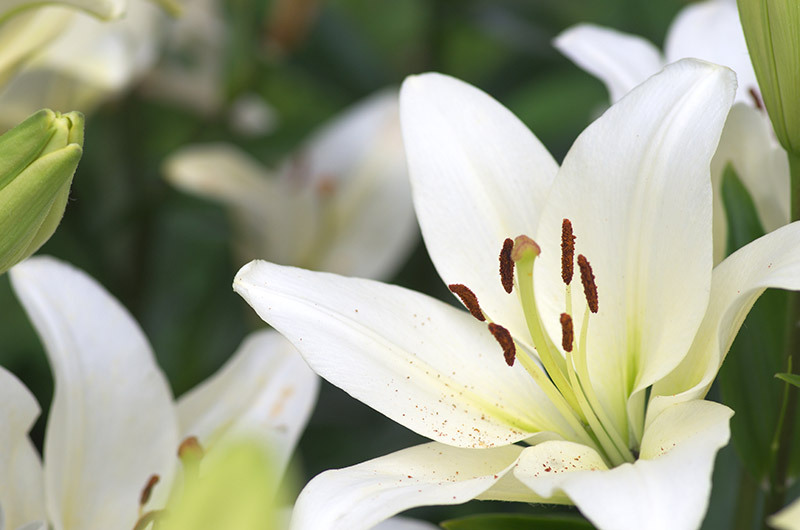Cut Flower Care: Maximize Their Longevity
Posted on 04/09/2025
Nothing brings life, color, and vibrancy to your home quite like a bouquet of fresh-cut flowers. Whether you've received a stunning floral arrangement as a gift, picked a bunch from your garden, or chosen blooms from the market, maintaining their beauty and freshness for as long as possible is important. Expert cut flower care not only enhances their appeal but also extends their vase life, allowing you to enjoy their fragrance and charm for days, even weeks. In this comprehensive guide, we'll provide effective tips and techniques on how to care for cut flowers to maximize their longevity and brilliance.
Why Proper Cut Flower Care Matters
Cut flowers begin to deteriorate rapidly once separated from the plant, losing their life support system. Immediate care and maintenance are crucial to slow the aging process and prevent wilting, drooping, or browning petals. Understanding proper flower care is not just about aesthetics--it's also about getting the most value and enjoyment from your blooms.
- Reduce Waste: Longer-lasting flowers mean fewer replacements and less waste.
- Emotional Value: Preserve memories attached to special bouquets by extending their life.
- Cost Efficiency: Less frequent purchases save money over time.

Factors That Affect Cut Flower Longevity
The lifespan of fresh cut flowers depends on several key factors. Understanding these can help you take the right steps to preserve flowers in a vase.
- Type of Flower: Some flowers naturally last longer than others. Carnations, chrysanthemums, and alstroemeria usually outlast delicate blooms like tulips or poppies.
- Initial Flower Condition: Flowers cut too early or late in their bloom stage deteriorate quickly.
- Water Quality: Clean, fresh water is essential for flower health.
- Temperature and Humidity: High heat and direct sunlight cause accelerated wilting.
- Vase Cleanliness: Dirty vases breed bacteria, shortening vase life.
Top Tips for Maximizing Cut Flower Longevity
1. Start with Healthy, Fresh Flowers
Select flowers that are just beginning to bloom for maximum vase life. Buds that haven't yet opened will last longer, while fully open blooms will wilt more quickly. Look for firm stems and vibrant, unblemished petals. If buying from a store, avoid flowers with yellowing leaves, brown spots, or mushy stems.
2. Cut Stems Properly
- Use sharp, clean scissors or floral shears to avoid crushing the stem.
- Cut stems at a 45-degree angle to increase water absorption surface area.
- Trim about 1-2 inches off the bottom, and recut stems every two to three days.
- Trim stems under water to prevent air from entering the vascular system, which can block water uptake (vase life increases dramatically with this method).
3. Remove Foliage Below the Water Line
Leaves submerged in water can rot and breed bacteria. Always strip away any foliage that would sit below the water line in the vase. This simple step can significantly prolong the life of cut flowers.
4. Use Clean Vases
A spotless vase prevents bacterial growth that can block stems and shorten flower life. Wash vases thoroughly with soap and hot water before use, and rinse out any previous residue. For stubborn build-up, soak with a mixture of bleach and water (1:10 ratio), then rinse well before adding flowers.
5. Choose the Right Water Temperature
- Most flowers prefer lukewarm water (room temperature) for optimal hydration.
- Bulb flowers (like daffodils and tulips) benefit from cold water.
- Change water every 2 to 3 days, cleaning the vase each time.
6. Feed Your Flowers
Flower food packets that come with bouquets are specially formulated to provide nutrients, control pH, and inhibit bacterial growth.
- Always mix the flower food as directed--too little is ineffective, too much may harm the stems.
- If you run out, make your own by mixing 1 teaspoon of sugar, 2 teaspoons of lemon juice, and a few drops of bleach per quart of water.
Sugar nourishes, lemon juice adjusts pH, and the bleach restricts bacteria.
7. Keep Flowers Cool and Out of Direct Sunlight
Display arrangements away from heat sources such as radiators, appliances, or sunny windowsills. Heat causes flowers to transpire and wilt rapidly. Aim for a cool location with indirect light to help your fresh-cut flowers stay beautiful longer.
8. Don't Place Near Ripening Fruit
Fruits emit ethylene gas as they ripen, which can speed up the aging process in flowers. Keep vases away from fruit bowls for peak cut flower longevity.
9. Remove Wilting Flowers Promptly
As some blooms begin to deteriorate, they release substances that can affect the health of neighboring flowers. Pluck out any wilted or dead stems to prevent them from spoiling the rest.
10. Mist Blooms Occasionally
Lightly mist petals with water using a spray bottle, especially in dry environments. This helps high-humidity-loving flowers retain moisture. Ensure leaves and petals dry quickly to avoid mold.
Special Tips for Maximizing Vase Life by Flower Type
Roses
- Remove outer "guard petals" to reveal fresher petals underneath.
- Recut stems every 2-3 days and replace water frequently.
- Remove all leaves below water level to avoid bacterial growth.
Lilies
- Remove pollen-bearing stamens with scissors to prevent staining and prolong bloom time.
- Keep away from direct sunlight and drafts.
Tulips
- Prefer cold water and a tall vase for support as stems elongate.
- Tulips keep growing after cutting! Trim stems as needed to fit your arrangement.
Daffodils
- Daffodils secrete a sap; let them sit alone in water for a few hours before adding to mixed bouquets to avoid harming other blooms.
Orchids
- Mist regularly and keep in a humid spot.
- Orchids prefer filtered light and steady temperatures.
Common Questions About Cut Flower Care
How Often Should I Change the Water in My Vase?
For maximum flower life, change the water every 2-3 days. Even if the water appears clear, invisible bacteria can quickly multiply, so regular changing is essential.
What Homemade Flower Food Recipes Work Best?
- As mentioned, a mix of 1 teaspoon sugar, 2 teaspoons lemon juice, and a few drops of bleach per quart of water is effective.
- You can also try 1 part lemon-lime soda (not diet) mixed with 3 parts water plus a half teaspoon of bleach for a homemade solution.
Can I Revive Wilting Flowers?
Sometimes! Recut stems and place flowers in a vase of lukewarm water for an hour in a cool room. For roses, briefly submerge the entire stem and flower in tepid water to refresh the bloom.
Do Coins or Aspirin Help Flowers Last Longer?
- Old wives' tales suggest that adding pennies or aspirin to the vase can extend flower life. While copper and aspirin may have a mild antibacterial effect, properly following the above steps yields much better results.
Prolonging the Beauty of Your Cut Flowers: A Step-by-Step Routine
Having a ritual each time you bring flowers home can help form healthy habits that result in longer-lasting arrangements. Here's a suggested flower care routine:
- Unbox and unwrap the flowers as soon as possible.
- Remove lower leaves and wilted outer petals.
- Fill a clean vase with the recommended water temperature.
- Add flower food according to instructions.
- Cut stems at a 45-degree angle under running water.
- Arrange flowers so no foliage is under the water line.
- Place in a cool, indirect-lit location.
- Check daily, mist if necessary, and remove any wilting stems or leaves.
- Change water and trim stems every 2-3 days.
The Do's and Don'ts of Cut Flower Care
The Do's
- Do use clean, sharp tools for trimming and arranging.
- Do clean vases thoroughly before each use.
- Do protect flowers from direct heat and drafts.
- Do remove dead or wilting stems promptly.
The Don'ts
- Don't let foliage sit below the waterline.
- Don't mix flowers that secrete sap (like daffodils) with others without pre-conditioning.
- Don't forget to recut stems before placing flowers in the vase.
- Don't display flowers near ripening fruit or in hot, sunny spots.

Enjoying Longer-Lasting Flowers Year-Round
With these cut flower longevity tips and advanced care techniques, your stunning bouquets will brighten your living space for as long as possible. Remember, the key elements are:
- Fresh water
- Clean vases
- Regular trimming
- Use of flower food
- Protection from heat and sunlight
Whether you're arranging store-bought blooms, garden-picked favorites, or floral gifts, investing a little time in proper care pays off with days--sometimes even weeks--of beautiful blossoms.
Conclusion: Make the Most of Your Cut Flowers
Maximizing the longevity of your cut flowers is simple with the right techniques. By following these proven steps on cut flower care, you'll not only enhance the beauty of your arrangements but also enjoy the therapeutic and aesthetic benefits they bring to your environment. The next time you receive or purchase fresh flowers, use these strategies, and savor every moment of their vibrant display.
For even more gardening and home inspiration, explore our related guides on keeping plants healthy, flower arranging tips, and DIY floral projects. A little attention goes a long way--happy flower caring!
Latest Posts
Navigating [AREA] Council Regulations for Outdoor Flower Displays
Curate Your Workspace with Low Effort Greenery
Cut Flower Care: Maximize Their Longevity






